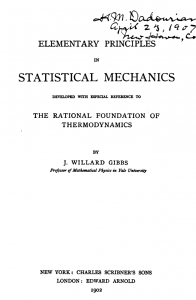I enjoy digging in historical physics publications, and want to share a document with you that might greatly simplify putting the concepts of statistical mechanics into context. Gibbs himself did an enlightening job in providing this context, in the preface to his essay titled “Elementary principles in statistical mechanics — the rational foundation of thermodynamics”, published in 1902. It is the very same essay that coined the term “canonical ensemble”, so if you ever wondered since when this term is actually used and who has defined it for the first time, this essay will be quite insightful for you.
Thanks to Google’s literature scanning program, named essay is freely available (not subject to copyright restrictions) on archive.org. According to the download counter, it has been viewed/downloaded only 540 times (at the time of writing this blog post), which is not a whole lot compared to the importance of the document. It can be obtained in various file formats, including PDF.
I recommend giving the preface a read. What follows now are a couple of quotations that I found to be a linear combination of enlightening and funny.
In the very beginning, Gibbs argues that thermodynamics is adjusted to the human capabilities of observation:
The laws of thermodynamics, as empirically determined, express the approximate and probable behavior of systems of a great number of particles, or, more precisely, they express the laws of mechanics for such systems as they appear to beings who have not the fineness of perception to enable them to appreciate quantities of the order of magnitude of those which relate to single particles, and who cannot repeat their experiments often enough to obtain any but the most probable results.
Also, Gibbs humbly appreciates the difficulty and complexity of describing natural phenomenons in accurate terms and resigns from making attempts in this direction. Instead, he proposes to change perspective, and praises the conceptual advantage of working on a theory which does not claim to have predictive capabilities. He stresses the beauty and simplicity of a self-consistent theory, and warns about introducing bias:
Difficulties of this kind have deterred the author from attempting to explain the mysteries of nature, and have forced him to be contented with the more modest aim of deducing some of the more obvious propositions relating to the statistical branch of mechanics. Here, there can be no mistake in regard to the agreement of the hypotheses with the facts of nature, for nothing is assumed in that respect. The only error into which one can fall, is the want of agreement between the premises and the conclusions, and this, with care, one may hope, in the main, to avoid.
Gibbs proceeds introducing the single chapters of his essay, and eventually comes up with the “canonical ensemble” terminus:
In the fourth and following chapters we return to the consideration of statistical equilibrium, and confine our attention to conservative systems. We consider especially ensembles of systems in which the index (or logarithm) of probability of phase is a linear function of the energy. This distribution, on account of its unique importance in the theory of statistical equilibrium, I have ventured to call canonical, and the divisor of energy, the modulus of distribution. The moduli of ensembles have properties analogous to temperature, in that equality of the moduli is a condition of equilibrium with respect to exchange of energy, when such exchange is made possible.
Gibbs stresses that a major outcome of the self-consistent statistical mechanics framework is that under certain conditions expectation values of ensemble properties may yield the thermodynamic quantities temperature and entropy:
We meet with other quantities, in the development of the subject, which, when the number of degrees of freedom is very great, coincide sensibly with the modulus, and with the average index of probability, taken negatively, in a canonical ensemble, and which, therefore, may also be regarded as corresponding to temperature and entropy. […] In Chapter XIV, this subject of thermodynamic analogies is discussed somewhat at length.
Gibbs concludes his preface with a sharp distinction between the theoretical concepts of statistical mechanics and thermodynamics on the one hand, and the properties of matter on the other hand. That one really is cryptic and beautiful at the same time:
Finally, in Chapter XV, we consider the modification of the preceding results which is necessary when we consider systems composed of a number of entirely similar particles, or, it may be, of a number of particles of several kinds, all of each kind being entirely similar to each other, and when one of the variations to be considered is that of the numbers of the particles of the various kinds which are contained in a system. This supposition would naturally have been introduced earlier, if our object had been simply the expression of the laws of nature. It seemed desirable, however, to separate sharply the purely thermodynamic laws from those special modifications which belong rather to the theory of the properties of matter.
Reading such texts — communicating nothing but the pure intent of the original creators — provides a perspective that may greatly simplify understanding and applying difficult concepts.

Leave a Reply